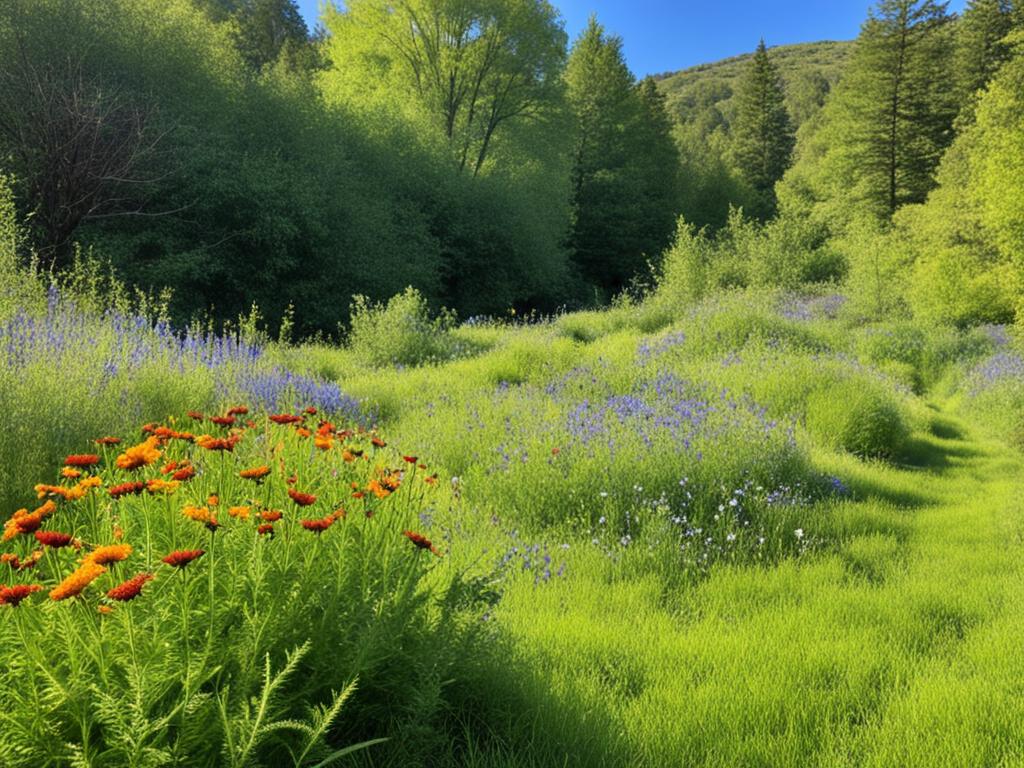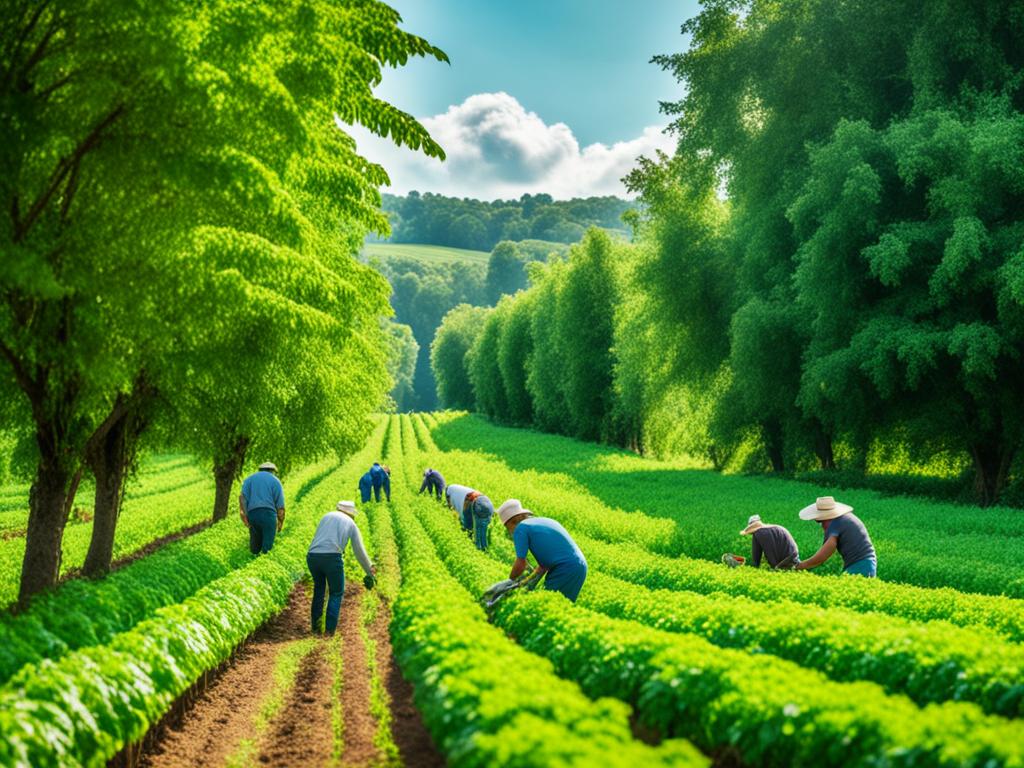Restoring ecosystems is a complex task. It covers projects of all sizes, from small ones to those that span large areas. The goal is to fix damaged habitats, boost biodiversity, and ensure a sustainable future. Ecological restoration is now a key part of the fight against climate change and loss of species.
Many people think restoration is just about planting trees. But it’s more than that. It involves many ecosystems like farms, peat bogs, grasslands, and oceans. Each one needs its own way of being restored. Some methods are passive, like stopping harmful actions to let nature heal itself. Other methods need direct human help, especially when ecosystems can’t bounce back alone.
Starting projects is just the beginning. Keeping an eye on progress and gathering data is key to understand their impact. Getting the local community involved is also critical. It helps connect environmental efforts with social and economic matters. This is crucial for the success and lasting impact of restoration work.
Key Takeaways
- Ecological restoration is a multi-scale effort aimed at habitat rehabilitation.
- Restoration practices extend beyond tree planting to include varied ecosystems.
- Approaches range from passive recovery to active ecological intervention.
- Monitoring and data collection are crucial for assessing project success.
- Local community support and leadership are essential for sustainable restoration initiatives.
Understanding Ecological Restoration: Key Principles and Concepts
Ecological restoration is a wide field that includes more than just planting trees. It involves fixing different ecosystems like oceans, grasslands, and soils. It’s key to include local communities for success. Indigenous ways of knowing and doing are critical for managing land well and saving diverse plant and animal life.

The Importance of Local Involvement
Local communities have a deep bond with their environment. This makes their participation essential in making restoration work well. By getting involved, the methods used are made to fit the local area perfectly. Plus, traditional wisdom can reveal things that modern methods might miss. This helps in managing the land better and fixing ecosystems for a long time.
Passive vs. Active Restoration
There are two main ways to fix ecosystems: passive and active. Passive restoration lets nature heal itself once the damage stops. This works well if the ecosystem isn’t too destroyed and can fix itself. Active restoration, though, means people have to help directly. This is needed when an ecosystem is too damaged to recover on its own.
- Passive Restoration
- Stopping harmful activities to let nature bounce back
- Works best for ecosystems that aren’t too hurt
- Active Restoration
- People step in to help, like by planting native plants
- Used when an ecosystem can’t come back by itself
Using these different methods correctly is crucial for ecosystem recovery. It helps to learn from other success stories. Yet, each project needs to be carefully customized. This ensures we truly help biodiversity and manage the land in a lasting way.
Effective Techniques for Ecosystem Recovery
Effective techniques for ecosystem recovery cater to specific ecological biomes. These strategies work on land and in the ocean. They focus on improving habitat health and bringing back biodiversity.

Agroforestry and Low-Carbon Agriculture
Agroforestry and low-carbon farming are key for restoring habitats in farming areas. They mix trees with farmland and use sustainable methods. Practices like no-till farming enhance productivity and ecological balance.
Reforestation and Natural Regeneration
Reforestation and natural tree growth focus on forests. They involve using native trees and enhancing natural growth. Careful management ensures forest resilience and diversity return.
Seagrass Reseeding and Coral Reef Restoration
Marine recovery uses seagrass reseeding and coral restoration. Growing coral polyps in nurseries and reseeding seagrasses works well. These efforts are crucial for marine life and biodiversity.
| Techniques | Application | Success Stories |
|---|---|---|
| Agroforestry | Integrating trees with crops and livestock | Enhanced soil health in Costa Rica |
| Low-Carbon Agriculture | No-till farming, sustainable grazing | Climate resilience in Brazil’s Cerrado |
| Reforestation | Planting indigenous tree species | Forest recovery in the Amazon |
| Natural Regeneration | Allowing ecosystems to recover naturally | Woodland expansion in Scotland |
| Seagrass Reseeding | Replanting seagrasses in marine areas | Increased marine biodiversity in Florida |
| Coral Reef Restoration | Nurturing coral polyps in nurseries | Revitalized reefs in the Great Barrier Reef |
Restoring Damaged Ecosystems: Techniques and Success Stories
Ecological restoration is happening all around the world. It tackles different environmental issues. Places like California, Brazil, and China have seen a range of projects. These involve various groups such as entrepreneurs, local communities, and government programs.
These efforts aim to fix the environment and also help the economy. They bring back diverse species and fight climate change. At the same time, they help local businesses in farming, fishing, and tourism.
The financial benefits of fixing ecosystems are huge. The services they provide are worth about $125 trillion every year globally. This huge number shows how important these restoration efforts are.
Different places need different restoration methods, for both land and sea. By sharing stories of successful conservation, we can motivate and guide new projects. This ensures our planet remains vibrant and sustainable for all who come after us.
| Region | Project Type | Economic Benefit |
|---|---|---|
| California | Forest Restoration | Supports Local Tourism |
| Brazil | Agroforestry | Enhances Agricultural Productivity |
| China | Wetland Restoration | Boosts Fishing Industry |
Biodiversity Preservation and Sustainable Land Management
The bond between saving biodiversity and managing land sustainably is key to restoring ecosystems. By mixing ancient wisdom with today’s conservation methods, we learn old secrets about keeping ecosystems healthy and balanced.

Utilizing Indigenous Knowledge and Practices
Indigenous knowledge provides vital insights for better restoration projects. Ancient farming ways, like rotating crops and mixing trees with crops, help the land. These methods work well with nature, enhancing both biodiversity and the land’s health and productivity.
Monitoring and Data Collection
It’s crucial to have strong systems for tracking the environment and gathering data. This lets scientists and conservationists watch how ecosystems change. They can see how well biodiversity is protected and tweak their plans as needed.
By collecting data constantly, they can adjust to ensure restoration lasts. This approach helps keep land management efforts on track for the future.
| Practice | Benefit |
|---|---|
| Indigenous Knowledge | Enhances cultural and ecological understanding |
| Environmental Monitoring | Provides data for adaptive management |
| Sustainable Land Management | Ensures long-term ecosystem health |
Inspirational Success Stories from Around the Globe
Inspirational stories of ecosystem recovery are found all around the world. They show the big effect of restoring nature. In the Amazon rainforest, combining farming with reforestation helps locals live better while helping the forest. These actions boost biodiversity and support small farmers, linking economy and nature care.
In Indonesia, bringing back primary forests helps protect habitats and species. Local people, NGOs, and government work together to improve damaged land. Their work shows that planting trees can help both the environment and society, making a better future for all.
In Africa, an effort called AFR100 aims to restore 100 million hectares of land by 2030. This shows how working together can fight land issues and climate change. Different countries in Africa are sharing ideas and resources to fix land, which helps farming and nature. This shows the benefits of restoring wetlands and other areas, like better ecology and economy.
These success stories show how important it is to work on ecosystem recovery everywhere. By taking part in projects to bring back forests and wetlands, communities contribute to a better, greener future. It ensures a healthy planet for us and future generations.


